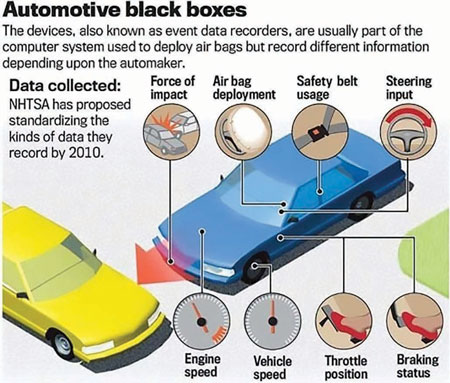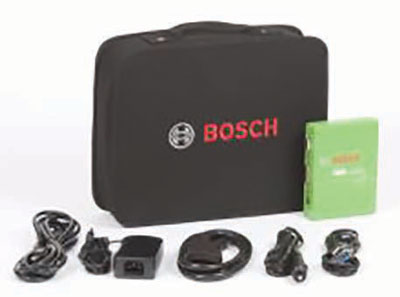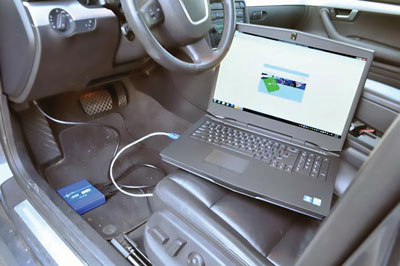
Popularly called a “black box,” an event data recorder is a device that records certain information from a vehicle immediately before and/or during most serious crashes. Police, crash investigators and others can download the data from the EDR’s memory to help them better understand what happened to the vehicle and how the safety systems performed. In some cases, it can help establish culpability.
Most EDRs are built into a vehicle’s airbag control module and record information about the deployment of airbags and belt tensioners, as well as pre-crash data from the engine control module, such as engine speed, throttle position and vehicle speed.
Some airbag and engine control modules store only diagnostic trouble codes and whether there was a signal to deploy airbags and belt tensioners. These modules aren’t considered to have EDRs, so they aren’t covered under federal rules. Devices that record vehicle speed before a crash or speed change during impact are defined under federal rules as EDRs.
Currently, EDRs aren’t mandatory, but most automakers choose to include them in their cars. In December of 2012, the National Highway Traffic Safety Administration (NHTSA) proposed a rule requiring the devices in all cars and light trucks.
Although EDR installation is voluntary, federal regulations do mandate that any installed EDR meet certain technical specifications. In August 2006, NHTSA issued an EDR rule that standardizes the information EDRs collect and makes retrieving the data easier.
This rule, which applies to 2013 and later models, requires devices defined as EDRs to record 15 data elements, including vehicle deceleration, in specific formats. More advanced EDRs may record additional information from the engine control module, antilock brakes and other vehicle systems.
Federal rules outline as many as 30 extra data elements that advanced EDRs must log. Vehicle manufacturers must ensure they are commercially available data retrieval tools or methods to download EDR data, and they have to include a statement in the owner’s manual telling consumers that their vehicle has an EDR.
As of model year 2013, all EDRs must record:
For EDRs capable of logging more detailed vehicle information, NHTSA requires the devices to record such things as sideways acceleration, forward or rearward acceleration, engine speed, driver steering input, right front passenger safety belt status, engagement of electronic stability control system, antilock brake activity, side airbag deployment time for driver and right front passenger and seat track positions for both the driver and right front passenger. Occupant size and position for drivers and right front passengers may also be recorded.
Currently, the vast majority of vehicles sold by major auto manufacturers in the United States have EDRs.
For most vehicles, the EDR data can be extracted by anyone using the Bosch Crash Data Retrieval (CDR) kit. In the U.S. market, Hyundai and Kia have worked with a third party to develop systems specific to their models. For Jaguar and Land Rover models, the vehicle must go through a dealer service center to access the EDR data.

EDRs in recent model vehicles, can gather information from frontal, side, rear and rollover impacts. EDRs in some older models, collect information only from frontal impacts.
EDRs can be used to corroborate findings from traditional crash investigation techniques, but they can also provide information about a crash that can’t be obtained through traditional methods. Police, crash investigators, automakers, insurance adjusters and highway safety researchers can use this information to analyze what occurred leading up to and during a crash.
The data may help automakers improve occupant restraint systems and vehicle structures. EDR data can be useful to either side in civil or criminal litigation. State law determines the circumstances under which it can be admitted in court.
Yes. As useful as EDR data may be to researchers and others, there are limitations, especially for older EDRs. Prior to the implementation of the federal EDR rule, some EDRs restricted data retrieval to the maker of the vehicle.
EDR data may not always survive a crash, however, EDRs that have been in IIHS front and side high speed crash tests (40 mph and 31.1 mph, respectively) have survived with data intact.
The Institute downloaded data from 15 2001-08 GM models and two 2003-05 Ford models after 40 mph frontal offset crash tests. The EDRs in the GM vehicles accurately recorded precrash speeds, airbag deployment times and belt use. They also recorded vehicle decelerations during the crashes. However, EDRs in 7 of the 15 cars stopped recording before the crashes ended.
The EDRs in the two Ford models recorded airbag deployment times and belt use, but both stopped recording vehicle deceleration data before the crash was over. Likewise, NHTSA reviewed the results of 37 crash tests in vehicles equipped with EDRs and found that the majority of EDRs didn’t record the entire crash event.
Data retrieved from newer vehicles subjected to IIHS crash tests indicate the EDRs are now capable of recording the entire crash event.
EDRs and the data they store belong to vehicle owners. This has long been generally recognized, but it was clarified by a federal law enacted in 2015. Police, insurers, researchers, automakers and others may access EDR data with the vehicle owner’s consent or through a court order.
Federal law also allows access without a court order under certain circumstances, for example, for emergency responses or for highway safety research provided that identifying information is removed.
Seventeen states have their own laws specifying who can access the data.
For crashes that don’t involve litigation, especially when police or insurers are interested in assessing fault, insurers may be able to access the EDRs in their policyholders’ vehicles based on provisions in the insurance contract. However, some states prohibit insurance contracts from requiring policyholders to consent to access.
Vehicles with a gross vehicle weight rating above 8,500 pounds are exempt from NHTSA regulations on EDRs. Many heavy trucks have engine recorders, which are not the same as EDRs and are intended to help evaluate engine use and performance issues.
Vehicles with a gross vehicle weight rating above 8,500 pounds are exempt from NHTSA regulations on EDRs. Many heavy trucks have engine recorders, which are not the same as EDRs and are intended to help evaluate engine use and performance issues.
Yes. Automatic crash notification systems are designed to alert emergency responders, including police and medical personnel, when crashes occur. These systems use data from EDRs, airbag sensors and global positioning systems to identify the occurrence of crashes, their severity and the location of involved vehicles.
This information is sent automatically by cell phone to emergency dispatchers or to staff at a private call center who forward it to local 911 operators.
